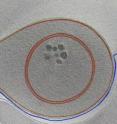Caltech team says sporulation may have given rise to the bacterial outer membrane
Bacteria can generally be divided into two classes: those with just one membrane and those with two. Now researchers at the California Institute of Technology (Caltech) have used a powerful imaging technique to find what they believe may be the missing link between the two classes, as well as a plausible explanation for how the outer membrane may have arisen. The "missing link" is a bacterium called Acetonema longum -- a member of a little-known family of bacteria that have two membranes and respond to extreme or challenging situations by forming protective spores, a process known as sporulation. Outside of this small family, only bacteria with a single membrane have been found to sporulate.
"When we started looking at Acetonema, we had no idea how unique and interesting it would turn out to be," says Grant Jensen, professor of biology at Caltech and a Howard Hughes Medical Institute investigator. "But when we imaged the sporulation process in this bacterium at high resolution, we saw that a piece of the inner membrane actually becomes the new cell's outer membrane."
The finding shows that because sporulation results in a second membrane covering a cell, the common ancestor of bacteria with a single or double membrane could have been a spore-forming bacterium similar to A. longum.
Jensen's group at Caltech is one of just a few in the world that uses electron cryotomography (ECT) to image biological samples. Unlike traditional electron microscopy -- for which samples must be dehydrated, embedded in plastic, sectioned, and stained -- ECT involves plunge-freezing samples so quickly that they become trapped in a near-native state within a layer of transparent, glasslike ice. A microscope can then capture high-resolution images of the sample as it is rotated, usually one degree at a time. Finally, those images can be stitched together to create three-dimensional representations of a specimen such as a single bacterial cell or a virus.
Postdoctoral scholar Elitza Tocheva, a member of Jensen's lab, was exploring possible projects when Jared Leadbetter, professor of environmental microbiology at Caltech, suggested the group collaborate to study a sporulating bacterium isolated from a termite gut. Leadbetter knew that the model for sporulating bacteria, Bacillus subtilis, was too thick for ECT, and this other bacterium, A. longum, happened to be relatively skinny.
Tocheva quickly realized that a unique subject had fallen into her hands -- not only was A. longum thin enough to image using ECT, but it also turned out to be one of the rare spore-forming bacteria with two membranes. The images she captured revealed the sporulation process in exquisite detail, and within the images, she noticed something interesting: in order to end up with an outer membrane after sporulation, an inner membrane had to be inverted and converted into an outer membrane. That's no small feat, given that inner and outer membranes are very different both structurally and functionally.
In the case of a double-membraned bacterium, such as A. longum, the sporulation process begins with the inner membrane pinching together asymmetrically, creating a mother cell and a smaller daughter cell, all within the outer membrane. Next, the mother cell engulfs the daughter, giving the daughter an extra layer of membrane derived from the original inner membrane. The product is a spore surrounded by two membranes within the mother cell. At this point, the mother cell dies away, leaving the spore protected by those two membranes and a protein coat.
When conditions improve and the spore germinates, part of its protective protein coat cracks open, allowing the new cell to outgrow, or exit, the protein coat. Unlike a single-membraned bacterium, which would at this point shed its outer membrane, the double-membraned bacterium retains it. Jensen's group found that the new outer membrane has all of the structure and function of a typical outer membrane, even though it originated as part of the mother cell's inner membrane.
"When the bacterium outgrows, one of its two membranes has to be converted from an inner to an outer membrane," Tocheva says. "This is very intriguing, and we don't know how it happens."
To prove that the membrane becomes converted to an outer membrane once it outgrows, the researchers had to show that Acetonema longum's outer membrane was like those seen in other double-membraned bacteria. They achieved this in a few different ways. First they showed that the outer membrane had one of the hallmarks of a true outer membrane -- the presence of an immunologically important macromolecule called lipopolysaccharide (LPS). Then they calculated the density of the membranes and found that the outer membrane was slightly denser than the inner membrane, as would be expected of a true outer membrane. Finally, they searched the genomes of about one thousand bacteria and found that A. longum had a full complement of the genes that commonly correlate with having a double membrane and having the ability to sporulate.
With all of this evidence in hand, the researchers were able to say that they were indeed seeing an outer membrane that was once part of an inner membrane. "We were rewarded with this kind of rich data of a sporulating bacterium," Tocheva says. "Acetonema was just the ideal subject."
Source: California Institute of Technology
Other sources
- Sporulation may have given rise to the bacterial outer membranefrom Science DailyFri, 2 Sep 2011, 0:32:17 UTC
- Sporulation may have given rise to the bacterial outer membrane: studyfrom PhysorgThu, 1 Sep 2011, 17:00:41 UTC
